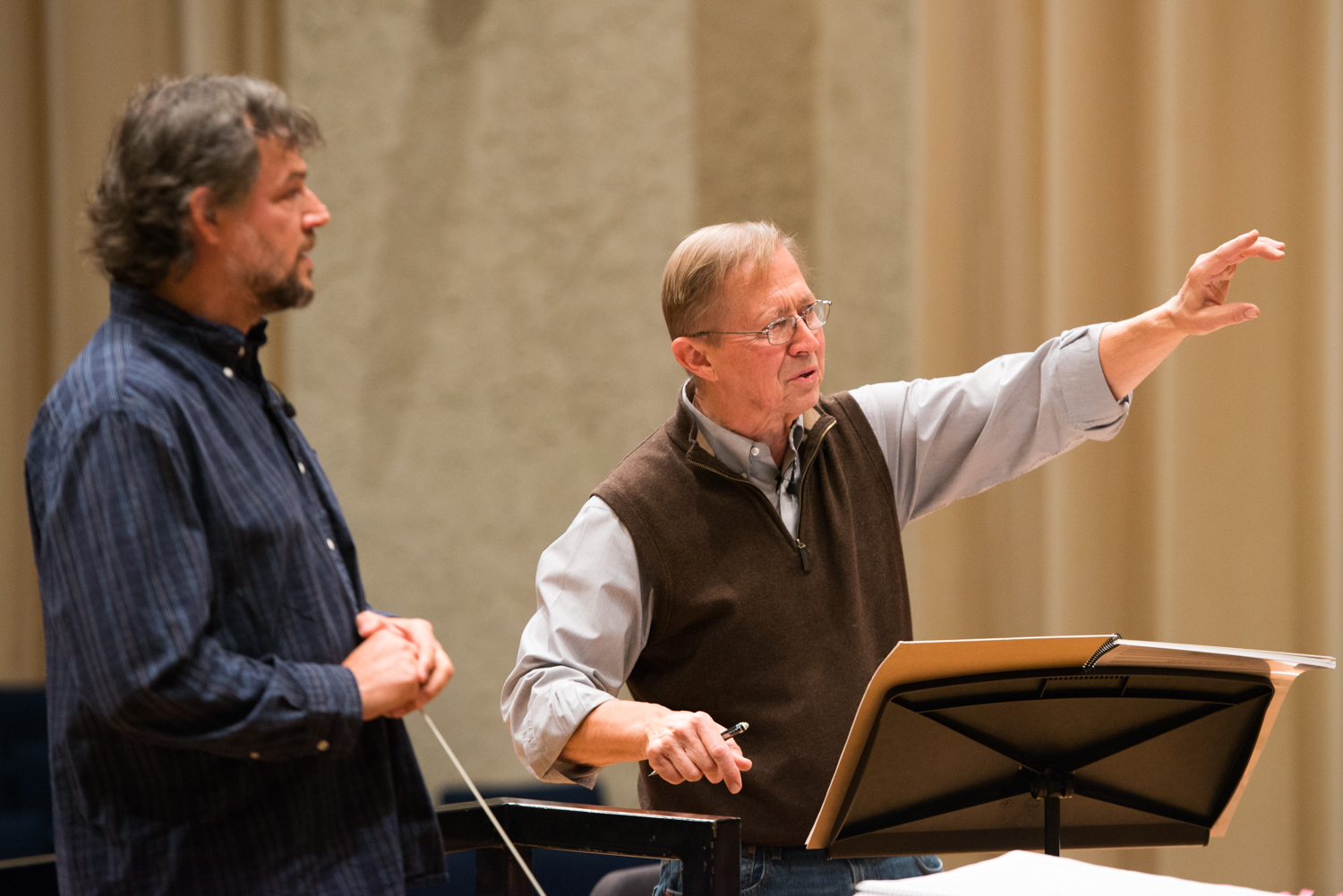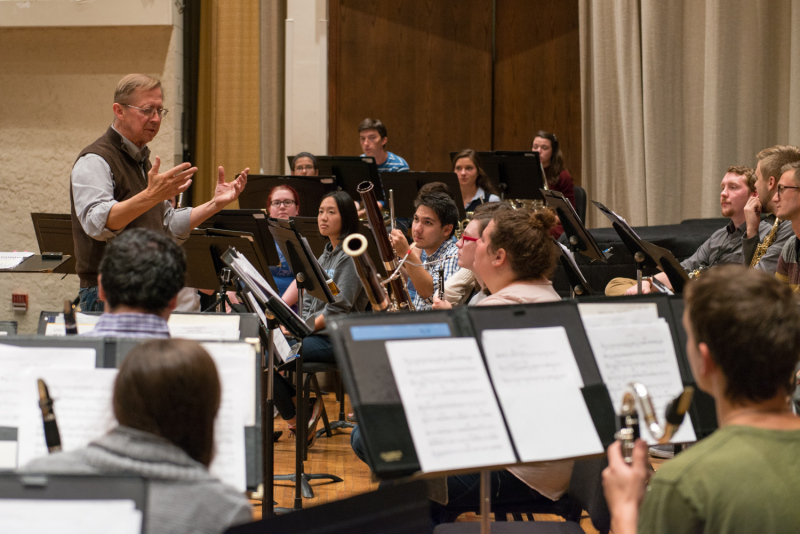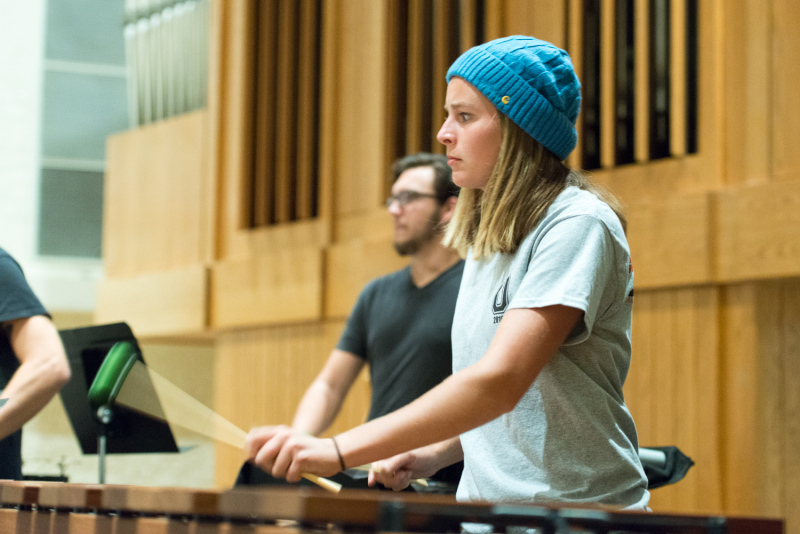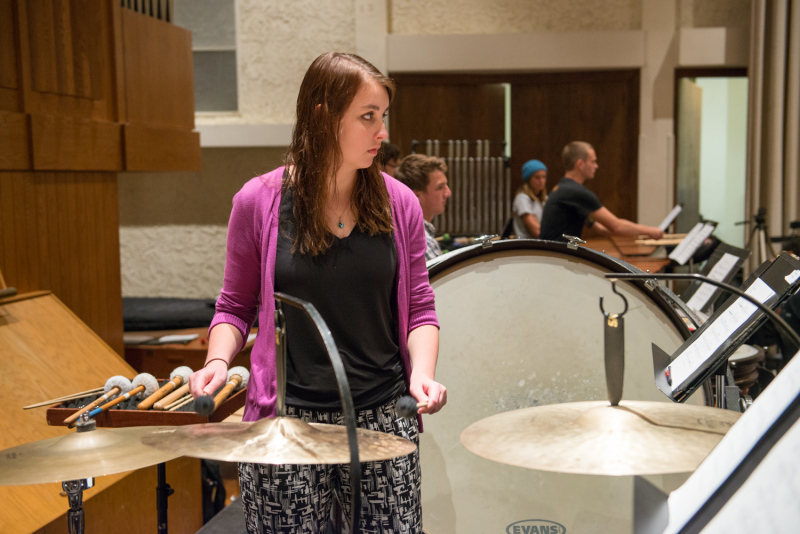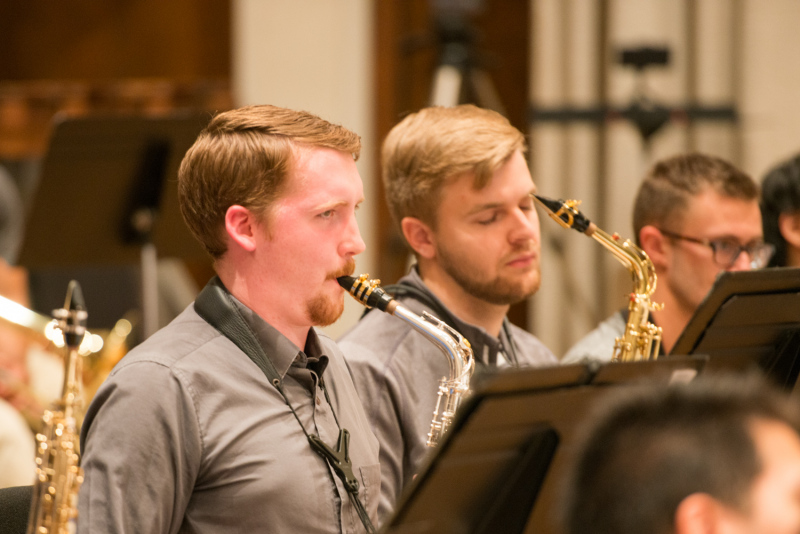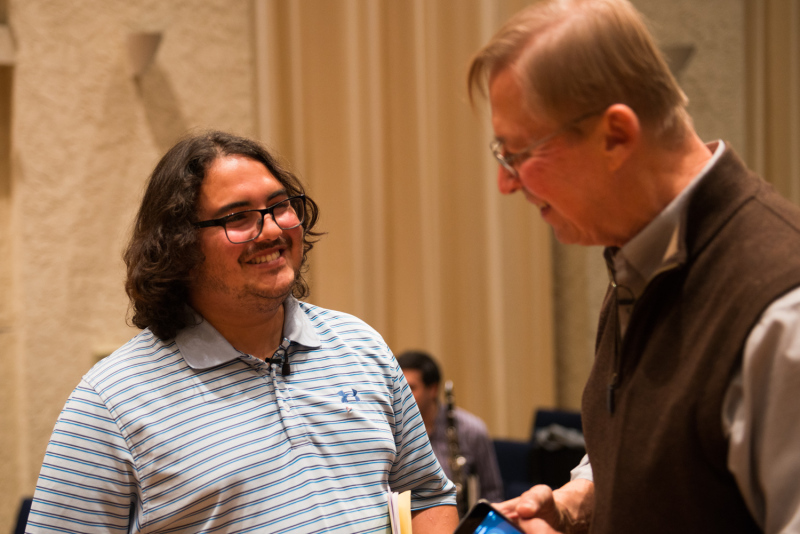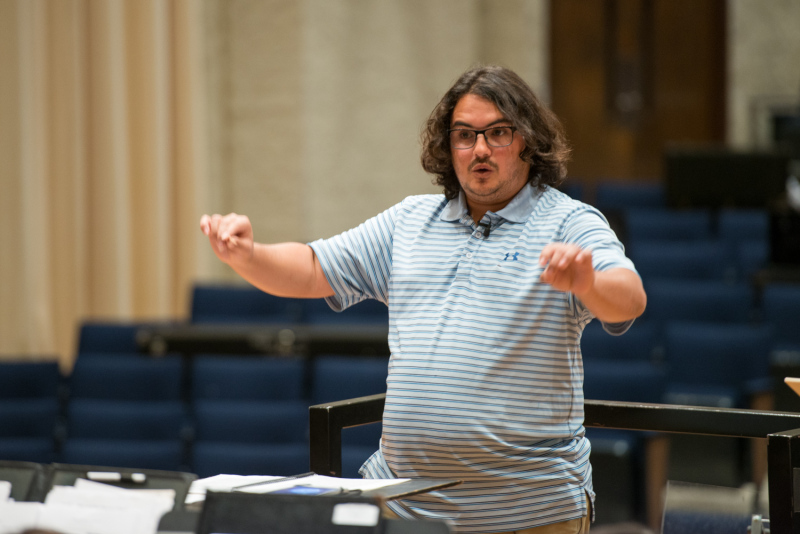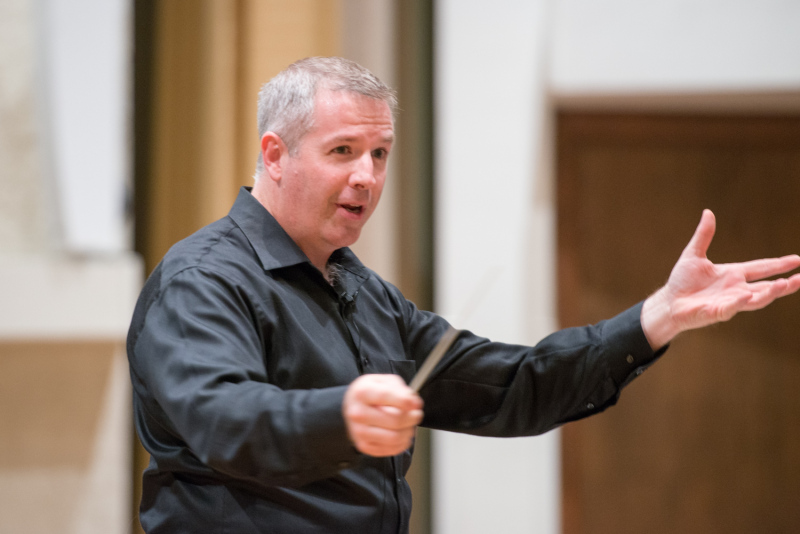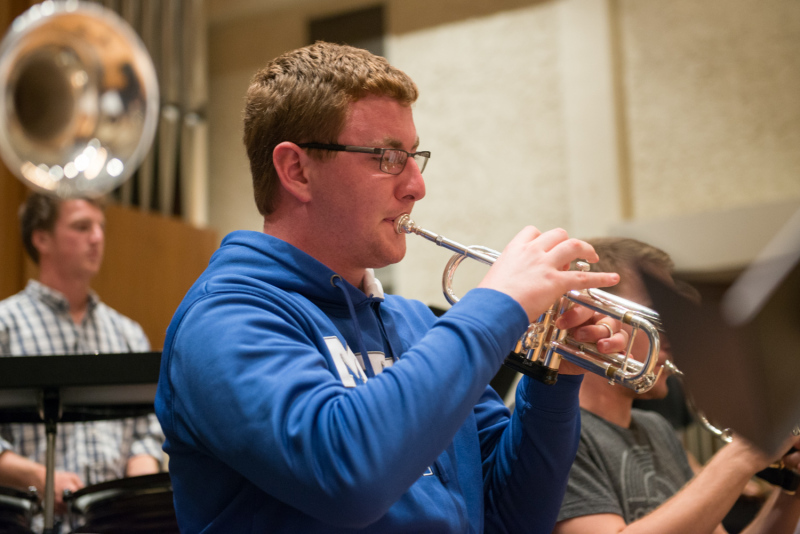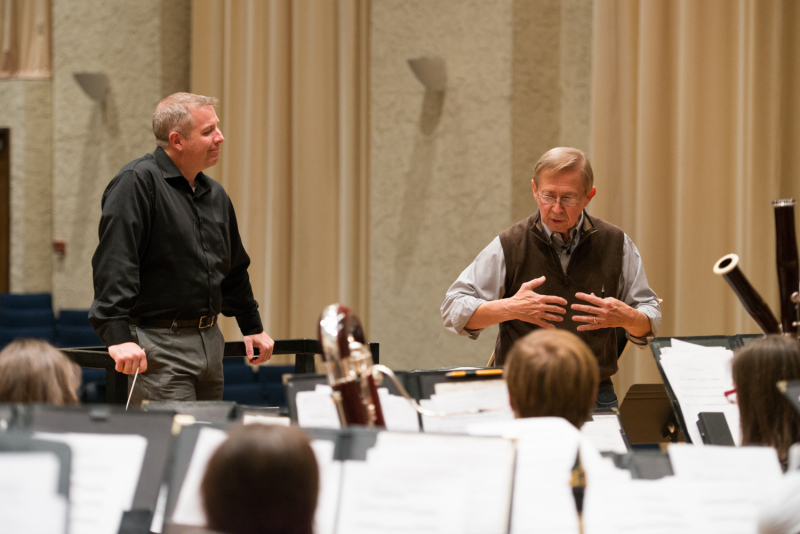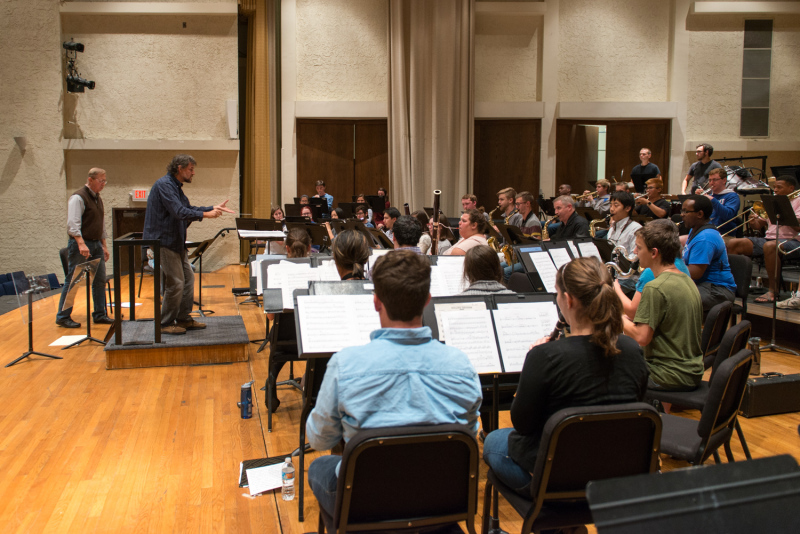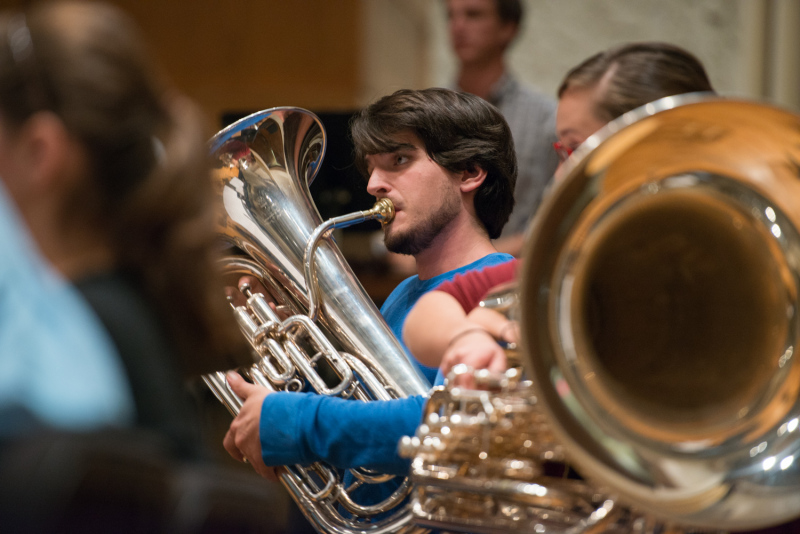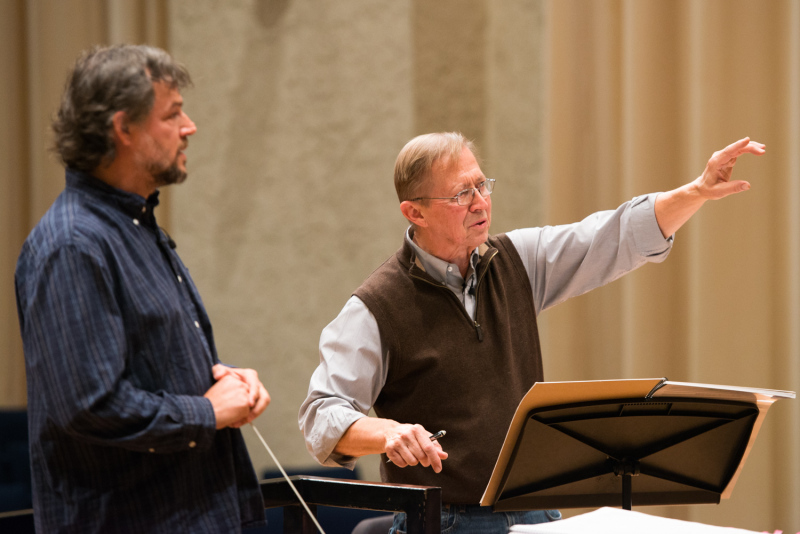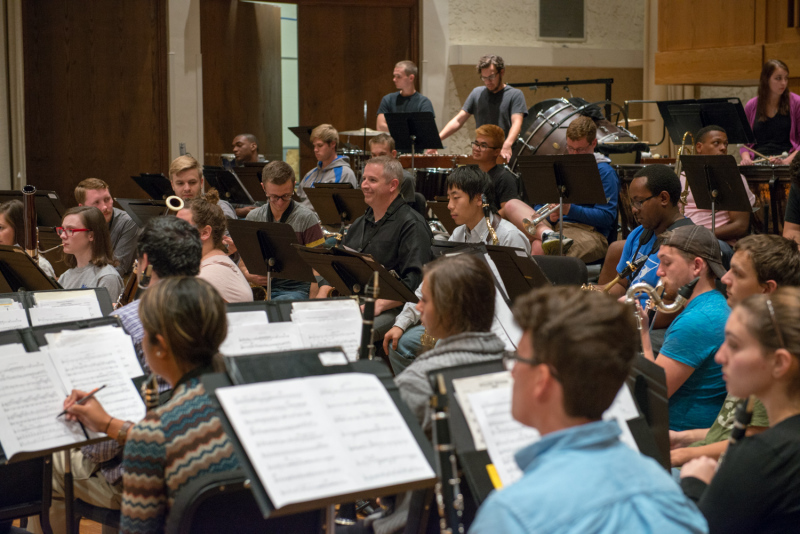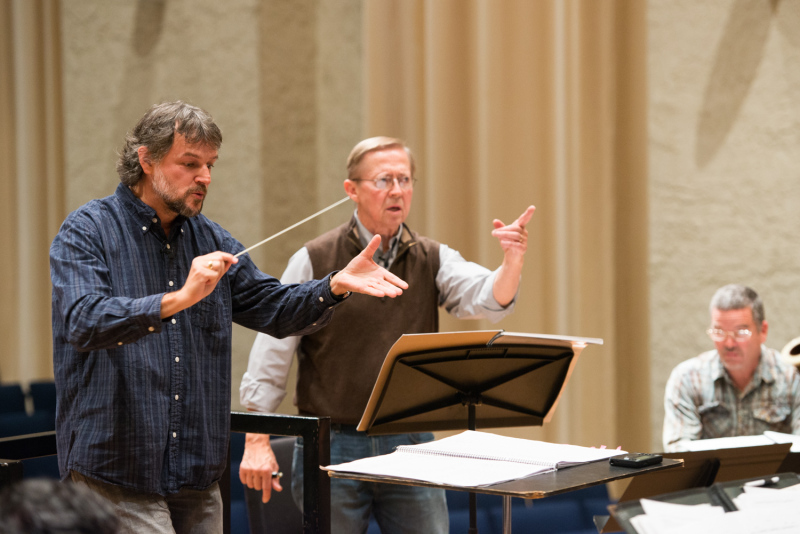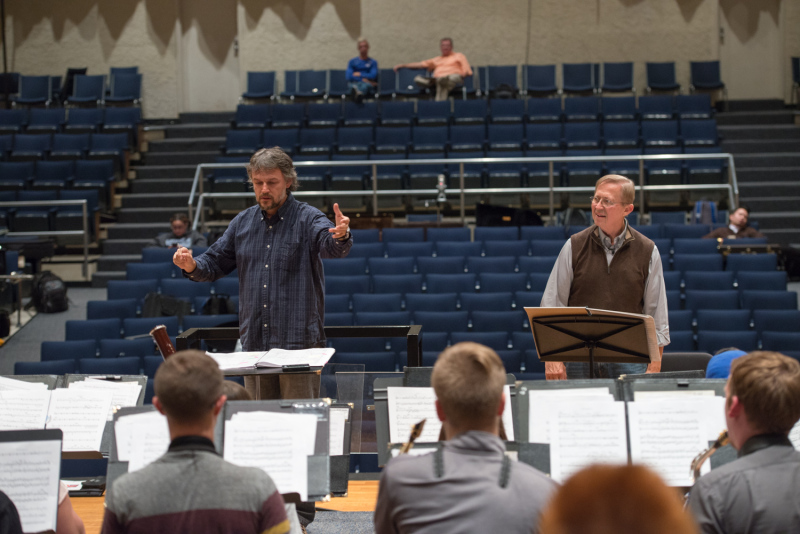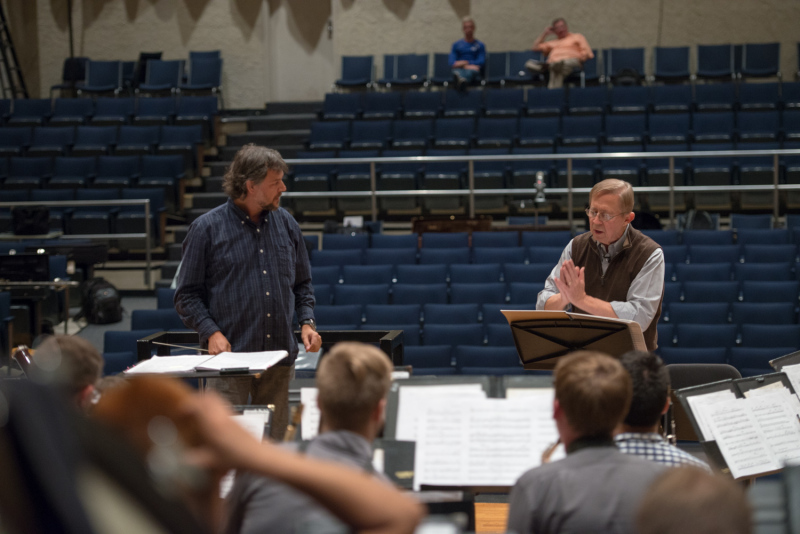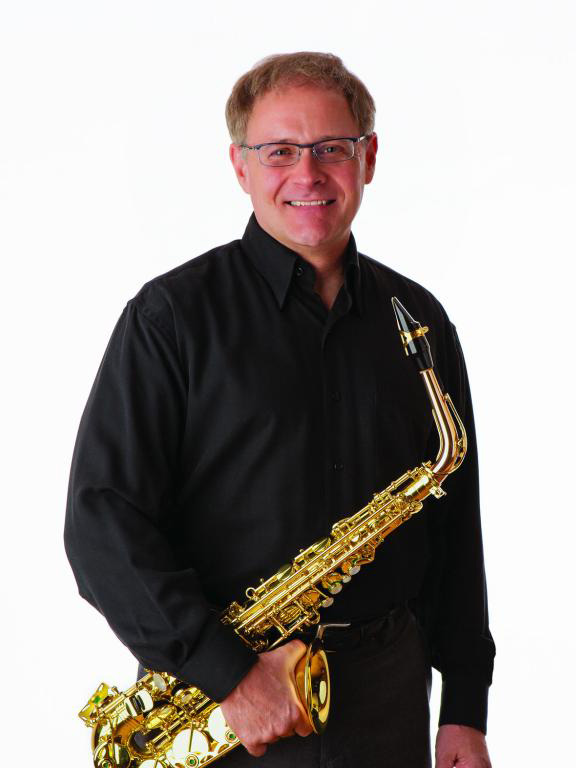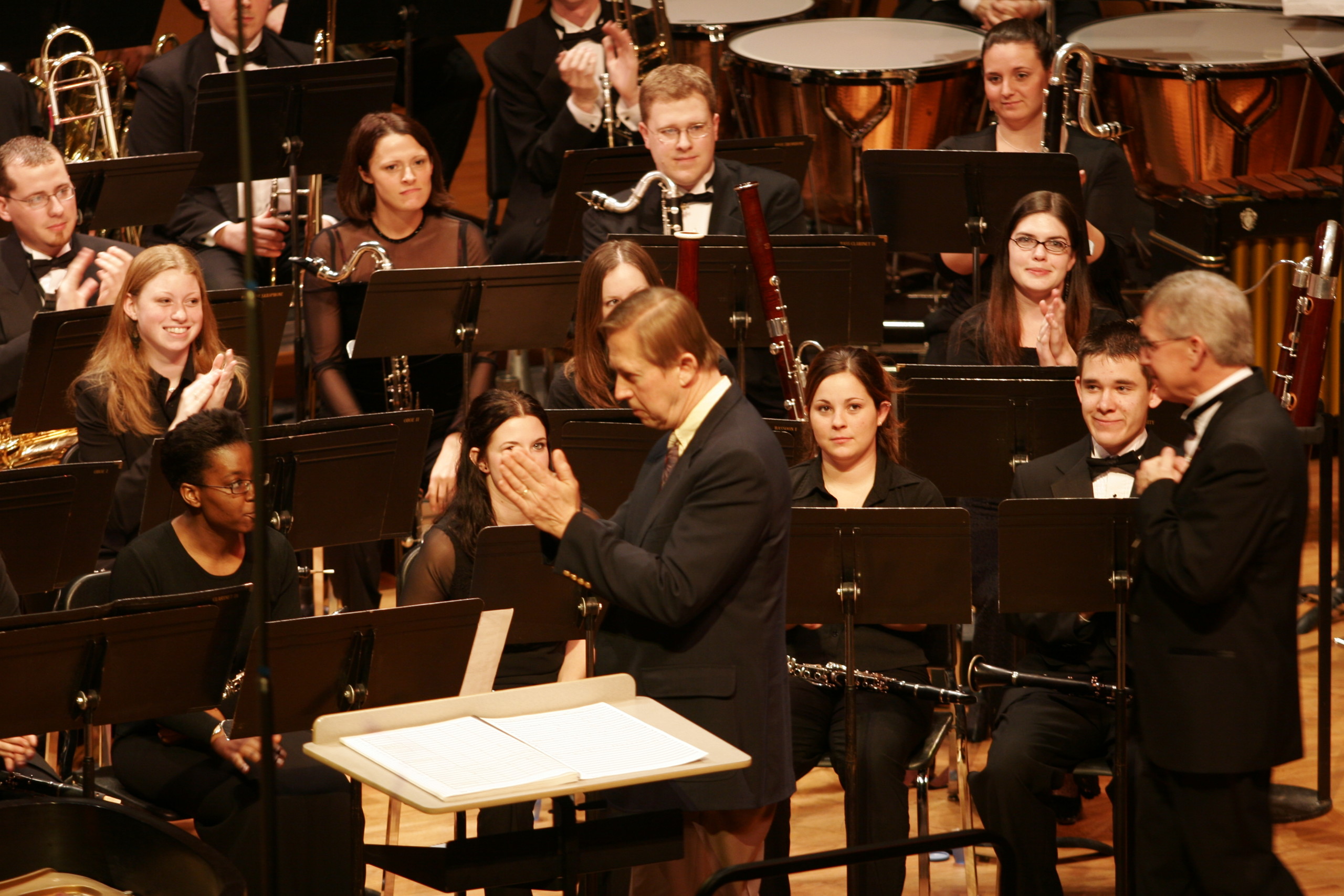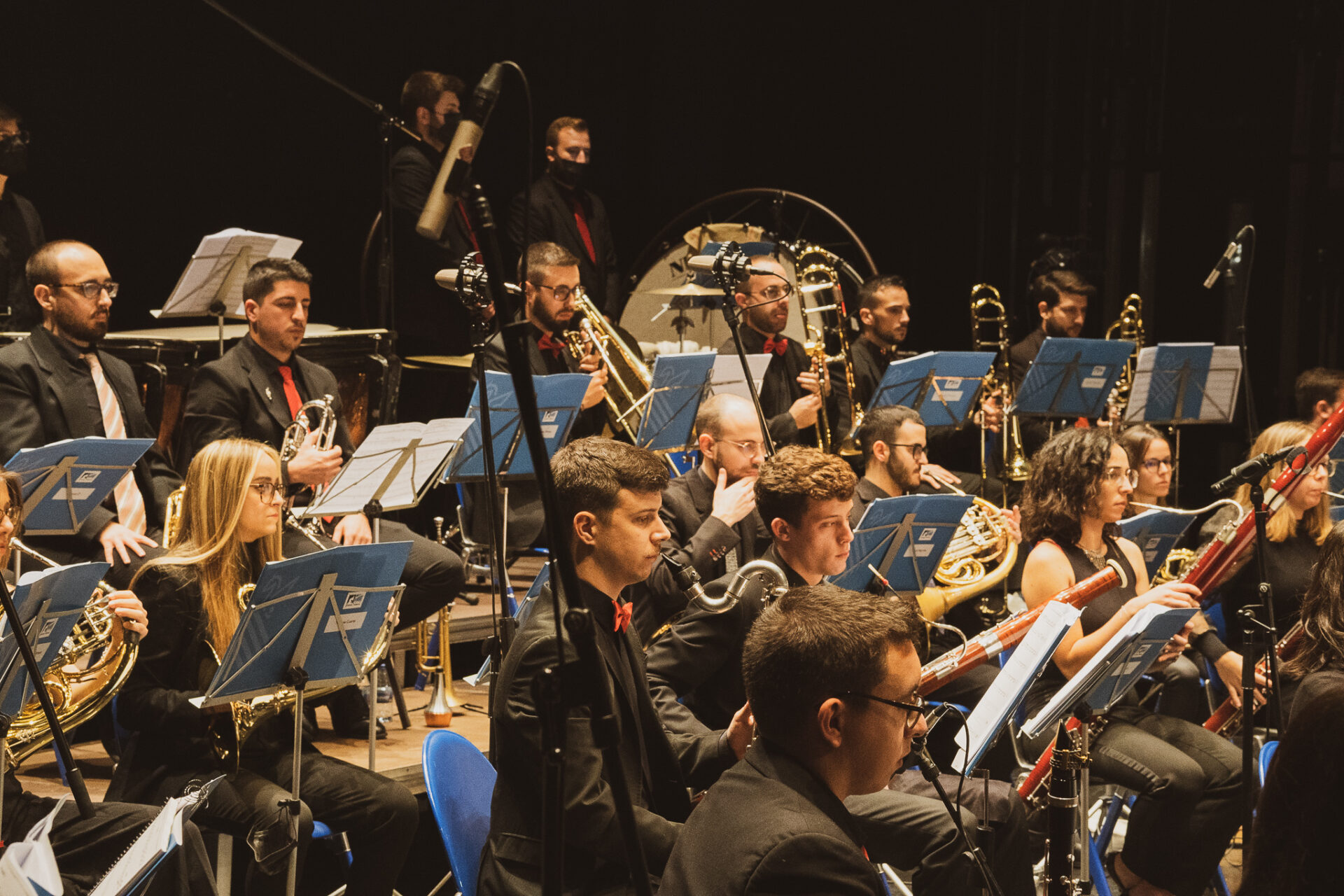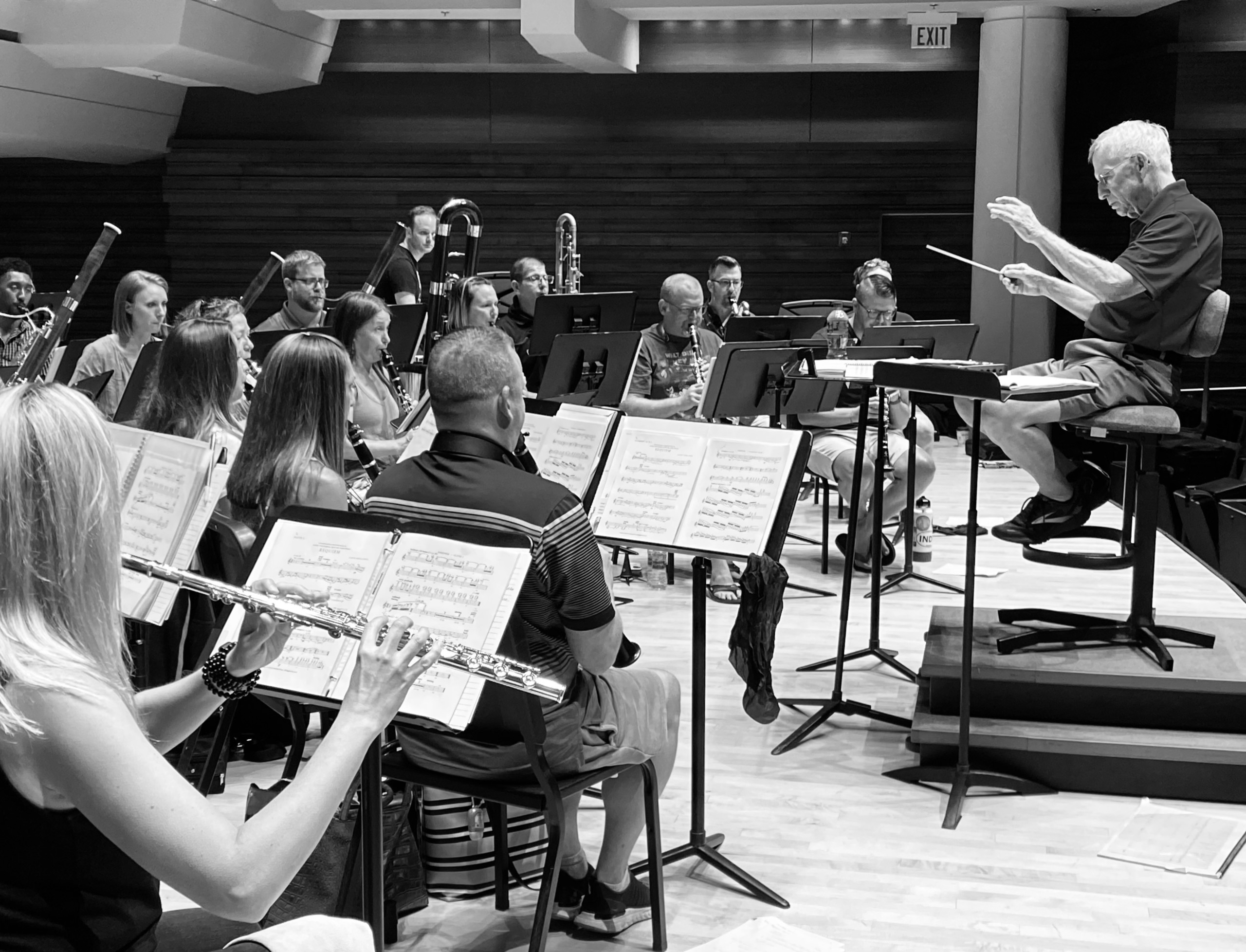In October 2016, I (Matthew Maslanka) accompanied my father to Middle Tennessee State University where I photographed and recorded his masterclasses and rehearsals. This is his rehearsal on October 25. He helped produce his final CD during this visit.
Audio Recording (1:22:57)
(transcript below)
Reed Thomas
Good afternoon, everybody. So, the plan for next couple of days, we’re going to start with some sections of Alex and the Phantom Band, then we’re going to move on, once we’ve had the chance to dress and get ready, we’re going to move to St. Francis. And the second movement, first, then we are going do the first movement and during those times Dr. Maslanka is going to be working with you. Helping, so we can make sure that we produce the music in a way that is the best of our ability. (inaudible)
So we are very privileged to have him here to work with us this week. So if you will please welcome Dr. David Maslanka.
David Maslanka
Thank you, it’s an honor and will evolve as a pleasure as we get going together. My whole need in the music making is just that, that we make music together, as opposed to technical chunks of this and that. We’re going to make music all through the rest of our week together today. So I want to start, not take too much time with you now just to let you know who I am. And we’ll start with our friend, Alex here. This is a neat little piece. It’s had some nice performances, especially for children. The last performance of this was in Beijing, China, with Chinese narrations, and very interesting to hear all that. So I won’t say any more. We’ll get started on this. And then we’ll begin our conversation back and forth. We’ll see what you sound like what this begins to feel like and then as I need to begin to talk about what to do. So when you’re ready, you can can start to work.
Wind Ensemble
(wind ensemble rehearses)
David Maslanka
One thought for solo trombone. Just a bigger sound. All right. So you’re, you’re the you’re the solo marked mezzo forte with a nice full bodied sound. And listen forward. Can you hear the oboe? Okay, and listen back. So you guys just come into into a pairing between you. Okay, but just take the confident breath and make a nice big sound right?
Wind Ensemble
(wind ensemble rehearses)
Reed Thomas
(giving direction)
David Maslanka
And both oboe and trombone, you get to measure 290, you’ve gotten to forte. And then it’s forte with accent staccato. So just a very solid “DUP BUP” to finish this thing, and you’ve made your statement. Boom, done. Okay?
Wind Ensemble
(wind ensemble plays)
David Maslanka
For those of you starting at 292, really assertive, “YUP, BUP, BUP.” And then very gradually you move down to your low space. But it’s left with an assertive gesture and 291 by the trombone and oboe, you pick it up that way. We are confident, and then we release into the solo euphonium. Okay.
Wind Ensemble
(wind ensemble plays)
David Maslanka
Okay, that’s it. Okay, go ahead.
Wind Ensemble
(wind ensemble plays)
David Maslanka
Sing more. (sings along)
Can I ask you to, at measure 290 horns, it’s just you guys. All right, you’ve got the second beat, and I need it “BAH”. “MMM BAH (indicates accented staccato note)”. All right. So you give me give me that one.
Now I want you, trombone, just sing, sing more. Right now you’re playing sort of tentatively. So sing the line, like you’re singing an operatic sound. Okay? All right? Do that.
Wind Ensemble
(plays)
David Maslanka
Okay, for euphonium, you have a beautiful sound and you’re capable of making that a lovely lyrical line. Your pulse is a bit off from your conductor’s, the tiniest bit out of phase with what he’s doing. I need you to be very close now into what he’s doing.
Wind Ensemble
(plays)
David Maslanka
Trumpets – where are you guys? I need a brilliant sound from you. It started out okay, and then it disappeared. All right, I need the full thing. From percussion. Your downbeat measure 190 has to take all of that energy and make it a pure fortissimo. Right now you sort of did it, but I need you just to bang into that and stay there with that. Okay, go ahead.
Wind Ensemble
(plays)
David Maslanka
Now that’s a nice pianissimo. Okay. Yours is marked fortissimo, or forte. Give it to me. All right. All right. You’ve got a got to do it. Play what’s on your page and play it with abandon. Just go for it. Alright.
Shorter grace.
Wind Ensemble
(plays)
David Maslanka
Tempo is too slow, so you are in the 140’s. So you need to be right at the 152.
Wind Ensemble
(plays)
David Maslanka
A certain inertia is beginning to crawl in and the tempo is beginning to fall backward and I can feel it when we get to the bassoons in measure 234. You must be aggressive in your tempo. And I want to just say altogether – be truly aggressive in your dynamics. If it’s marked forte piano, give it a punch and don’t be afraid of that, right. Just give it a little bit of teeth and claws. Always, right? So, soft sounds – pianissimo, piano – have to be that. Forte fortissimo – go the full distance immediately. All right, right. Beginning to sound nice. I like this music.
Wind Ensemble
(plays)
David Maslanka
Saxophones, as a group, you can make a lot more sound than that. Just do it. Okay, can you go right there at the measure 239 with a true fortissimo accent, blah, blah, blah, etc, etc.
Wind Ensemble
(plays)
David Maslanka
That’s nice. Yeah, that quality of brightness for you guys, for saxophones. That’s yes.
Reed Thomas
(give direction; wind ensemble plays)
(gives direction)
David Maslanka
You’re beginning to have the feeling now as you play this music from the heart with a full heart. When you have a beautiful solo, you let it blossom. You know it’s not about just making nice, it’s about letting it blossom and come through you in a beautiful way. The same for trombone when you have your solo – just here I am. Yeah, okay. An the ensemble now is beginning to show that brightness and quality which I like.
Okay, that’s marked fortissimo. It’s marked fortissimo, and where are the chimes? Okay, neat. Yeah, okay. All right. Just do it guys. All right.
Wind Ensemble
(plays)
David Maslanka
Your tempo there is a bit slow. The marking of 90 has to be that much, right? It feels like it might want to be a little bit slower but it’s not. Okay, for percussion, at measure 424, you have to give that energy to the whole ensemble when they come in at 429, which means you got to do it. Triangle, I’ve got to hear some sound. You have a bigger instrument somewhere? Okay, you just have to be surprising. That’s a nice pianissimo. I need, I need big sound from you. This is that measure 424 (inaudible)
Okay, let’s put it in context. So that you know but you just just rival everybody. Push them so that your sound is in there. Okay. Can you go there 424? Is that good?
Okay, no. At 424, you have a tremolo, no? It’s not single strokes. It’s tremolo. (cross-talk)
You don’t have it? Oh, gosh. Oh, so there we go. All right. So 424 through, all the way, all the way through. Yours is tremolo all the way through until downbeat of 434. And then you change to cymbal. Okay, so that’s the quality. Alright, sorry. You just go for now.
Timpani (David sings along)
Two things that I need from you – at 437, tam tam, who has it? That sound has to be damped immediately at 437 so that other things can come through. For the percussion, vibraphone you’ve got forte in measure 437, then a mezzo forte, then a mezzo piano, so grade your sound so that they come down appropriately. And chimes, the wind chimes fade with your conductor. He’ll be the one to tell you when to release that. Okay? (inaudible, speaking with Reed)
Yeah, right. There is a breath point, right, breath with a little bit of a fermata over it so that you have a separation there. Okay, now, full ensemble. This is measure 431, the tempo is here and your triplets are slow. You’re pulling your conductor backwards on those triplets, ok? (demonstrates 3:2 pattern). Okay, so be right there with the game.
Wind Ensemble
(wind ensemble plays)
David Maslanka
You’ll start in the fast tempo and then I think go immediately. Is that what you’re going to do? You’re going to start with (sings tune) and then go to two. Did you want to start that? Or I thought that’s what you did, but no. Okay? So give them the fast tempo and then you can move into the two.
Wind Ensemble
(wind ensembles rehearses)
Reed Thomas
(gives direction to wind ensemble)
David Maslanka
All right, 474. At 476, trombones, you have a big responsibility into 477. You’re the ones that move that bar (sings trombone line). It has to be solidly there. Push your tempo with your conductor. Right now inertia begins to come in again. So find the 180 and make sure you stay right in it. Okay. There it is. It’s a bit faster than you want to think it is. Alright, just go for it.
Reed Thomas
(gives direction)
David Maslanka
I think everything that you can give it, yes. Let’s do one more to solidify that. Okay. All right.
I want to say just one thing before we go a little bit further. And, you know, we’re starting a process now of three days of intensive rehearsal recording, and it gets, it can begin already with a sense of, “Oh, God, we’re going to get it.”
And I want you to go the other way. To give yourself the sense that we are playing music. We forget about the word play. We play innocent we play. Play, which means to have a good time goofing around with something that you really like to do. All right. And that’s how I want to go with this music with you. Right? So feel the joy, feel the exuberance of this music. Let yourself just flow with it. We will stop you, will say do this, do this do that. And point at trombones and say do better and stuff like that. Right. And you will, okay. And just let yourself go into this now. Alright, have a try it.
Reed Thomas
(gives direction)
David Maslanka
Yeah, that’s fun.
Wind Ensemble
(WE resets for Saint Francis)
David Maslanka
A cool little piece. Been so long since I’ve actually got in front of it to start
Reed Thomas
Would you like to start the beginning?
David Maslanka
We’ll start with what we just did when I hear something that I need to say then I’ll say
Just do the same process we just did. Okay?
Mind if I say a word or two okay.
Once you once you feel settled, I just want to say a word or two about why this title, why St. Francis?
And anybody who who knows anything about St. Francis? Are there any people who have had any background with St. Francis at all? One person raises a hand.
St. Francis was a 13th century Christian. He started off as a son of a noble person, not a noble, but a wealthy merchant, who wanted them to go into the business. St. Francis as a young person was party boy. Yeah, he was a singer, player, a party boy, this is what he did, until he had the experience which knocked him over completely. And he found himself opened, opened to a very powerful, spiritual ideal. And it moved his life into a radical place.
The idea of radical poverty, that is of having literally nothing and the people who followed him having literally nothing. With the absolute trust in the force of the Divine, to work through them, and it did. Now, this ideal of St. Francis has come through the centuries since – it touches many people.
And I’m going to show something. We think of St. Francis, if at all, as the saint who talked with birds and animals, who was a kindly kind of presence. And he wasn’t that at all.
Yes, he did talk to the animals. He was a fierce, fierce person, fiercely dedicated to what he was doing, fiercely open to the power of the Divine to come through him in an absolute way, in a way that we cannot understand now. If you saw this person in front of you today, this would be a crazy person.
We look at it that way, you know, but what I came to, because I had a dream of St. Francis some years ago, and I’ll share that with you just a little bit. The dream was a very simple one – it was of being backstage in a theater like this and being shown what appeared to be a sculpture. And it looks sort of like a bowling pin. But it was metal. And the person showing it said, you cannot approach this thing because it’s thousands of degrees hot. And if you do, if you try to touch it, you will kill yourself. All right, that was the dream, end of dream.
And in my meditation on that dream, I then approach it in the same way, see the object and say, “Alright, I’m going to touch that and see what happens.” And I did. And that object turned into the human figure of St. Francis. He was dressed however, as a Chinese peasant. And in one hand, was an African child and the other half of the Asian child.
And that was a message to me that music has to go out through the world, has to go out to the world, music has to go out through the world, and through children. And then through young people, such as yourself, and then as you go out and become teachers, you will bring that ideal of essentially power and peace to people through your music, and through your teaching. And that was the message of Saint Francis.
So that thousands of degrees hot thing is St. Francis. That thing which you cannot touch that heart of God essentially is the thing that you cannot touch, but which can now move through you.
And this is what happens in this music, it becomes hot and overwhelming. And this is where we go with it. So I wanted you to hear that and to know that this is where I am with that. And that title St Francis came to me as this piece began to arise. Pieces of music arise in dream fashion. It’s not like “oh, what’s my form? What’s my tune?” No, there’s a large dream begins to form around a certain issue. And then it begins to reveal itself and it goes “Oh, that. This is what that is. Okay.” And then we have what’s printed on the page. So that’s enough to say I think to get you started with this and let’s see where we go in our music making.
Wind Ensemble
(wind ensemble rehearses)
David Maslanka
I’ll stop you here.
You have a beautiful sound forming here. And I want you now to understand your relationship. The piano always has to be heard. You are the eigthth-note pulse. So if you cannot hear the piano, then you’re playing too loud. Saxophone, a beautiful tone, beautiful sound. Stay in that that dynamic range, no higher. The same with flute – you do not ever rise out of a piano dynamic range. Timpani, I need a quality of pointed sound so that you make your presence known – it’s not just a muffle. Alright, so you are a timekeeper kind of thing there. So either a slightly different place on your drum head or a slightly firmer mallet or something of that sort. Okay, give it a try.
(commenting to players) In time. Sixteenths are too fast. No breath. Flute and saxophone one sound.
I want to take the time here, and also with the saxophone solo that your dynamics are directly as written. Diminuendo in measure 20, a crescendo in 21, and no break over the top. So you have to have big air. Okay? So wherever you want to find yourself will be alright. This is hard, isn’t it? Okay, 11 is a good starting point. Okay.
Give yourself more sound. That’s good. Now release it.
Yes. Patience.
I need more the vibe sound. Not much, just a bit. In time, strictly in time.
Bigger, bigger. Start it.
Some odd noise in here. I just want to find out what is happening in terms of the sound. Can we go there? Can we go at measure 85 one more time. Measure 85. Is that alright?
Okay, all right now I cannot restrict your ability to play down to nothing. Clarinets are easily playing that range, oboes it’s more difficult for you to play that clear pianissimo at that range. So, you take it, you give it as much air as you can and make it as an ethereal sound as you can find there. Okay? Try.
Okay, now when you playing in this passage, right? It’s marked piannissimo. There is no crescendo, absolutely none. All right? Trumpets, I need you to balance your sound, trumpets trombone, so that you feel that sonority. Can we just hear that at measure eighty-six? Just you three people. Let me hold it and sustain it and feel it. See what it feels like. Ready? And (brass plays)
Okay, I’m hearing more first trumpet than I am second and trombone. And bring the first trumpet down a little tiny bit. Ready? And now. (brass plays) There you go. Okay, that’s your sound. Okay? And bring that into the piano. So let’s get everybody started at eighty-five. All right.
You guys, match that sound now.
Oh, that sounds good. Yes.
Enough air. Go ahead. Go ahead.
Oboes, add more air, a little bit louder. Be brave.
Nice crescendo now. Come on, come on. (sings)
Wherever you want to be.
Reed Thomas
(discussing starting place)
David Maslanka
No diminuendo, Nelson. Okay, I have to. You have the solo line here. And so when you get through measures 98 (sings), a breath, but don’t let your line break. Okay? You stop the tone before you get to the last two beats, but you need to know musically go across the line. (sings), and then no diminuendo. (sings)
Okay. Drama, right? Drama. Make it happen. Okay?
Yeah, one thought for you all, as an ensemble. Most of you have finished playing your instruments at this point in the piece. And I don’t want you to check out. Okay? I want you to keep your attention fully on the sounds that are being made. When you do that, you bring your consciousness to that sound and that sound comes to life. If you guys check out, then he’s all alone. And the reality is that you are still fully making music with him. He’s the one speaking but you’re the ones energetically supporting what his speech is. And then it becomes really powerful.
So try that now. And I want you to pay full attention to the sounds that you hear. It’s going to be the piano. It’s going to be largely the saxophone, you hear the clarinets occasionally, but you examine that sound with your with your consciousness. Taste that sound. I like that way of thinking. You taste the sound. What does it taste like to you that sound? And you’re going to hear all its stuff happening. And you go, “oh my god, oh my god, listen to that.” Yeah, this will be your experience when you hear this thing happening. So bring yourselves forward. Don’t let yourselves simply collapse into “I’m done,” you know? And then we’ll try. So where you want to start now?
Make your drama now (sings)
Follow your conductor
Quieter, a lot quieter. Take your time. Take your time. Take your time.
Okay, let me ask you now, this is at quarter equals 54 but you have the fermatas so you start the first (sings), let it breathe.
Second one (sings), let it breathe.
And then there’s no more bass, but you are still in tempo at measure 122, so it’s still (sings). And so try it. Go right there, would you please? Measure 120. And I don’t think you need to conduct them at this point. I think that he’s on his own. You finish the piece. It’s all by yourself. Okay? So you do it without having to worry about connection here. So go right there.
Take your time. Breathe. Take more time. I’m going to ask you to do that. Your tempo is here. This is 54 (snaps tempo). Okay? Internalize that but then let your fermatas breathe more. Alright, take more time. Do it one more time.
And, all of you, take a deep breath with, you know, I’m going to give him the beat, but I want you to breathe, and the upbeat with my breath in, and let it out on his downbeat. Okay, cool with that?
The pedal stays down, all the way. Okay, all right. So, as a group, take a deep breath now.
Okay, tempo is here. 1234. Okay, take that tempo. All right, and breathe with me now, everybody.
And let it ring, and play softer. Go ahead on your own.
Listen to it. Pedal stays down. No, you have a whole measure of sustaining that okay? No, your pedal must stay down. We’re going to this is a radically important that we get this straight so that we know what we’re doing here. Okay? Your pedal stays down the entire distance. And then you’ve got that measure of rest. Let’s take the time we’ll do one more of these. Okay, and this is everybody breathe with him and pay attention to fully his sound. I want you to live in his fermatas.
This is where I’ve come to as a musician – I can live in single tones. There are entire lifetimes in single tones, entire lifetimes. Universes in single tones.
Alright, and I want you to experience that now with this sound. Alright, here it is. All right. Okay, yeah, you found out how to do that now. Okay. I would like to do a couple of things with you. (talk with RT)
What I would like to do is to go to measure 41, and this is only people who have the fast notes here. Just you. So this is going to start with clarinets, saxophones, vibraphone, marimba, and anybody who has fast notes join in. But just you. None of the other sustained tones, okay?
Okay. Now, let’s do a thing here. This is for alto saxophone, and clarinets one, two and three. At measure 41, play and sustain only your first tone – just one tone, play and sustain fortissimo. Here it is ready, and (instruments play).
Make it bigger. Ready, and (instruments play)
Get your attack ready, and be ready to do bigger. Ready, and now (instruments play)
That’s a fortissimo. What you were doing before was a mezzo forte. Okay? Now I want you to start there with your conductor. And at that, that’s your quality of tone that you must sustain. I don’t care if you miss notes in this passage. I do care if you don’t have that sound. Okay, so move that sound. Try that, go ahead. Just you guys.
Okay. What you heard, what I heard, which is at a certain point it kind of fades out, right? Right because your fingers kind of go, “oh my god, I don’t know what I’m doing here.” Right. So this means that I need you to get some some finger time so that you are more comfortable with this all together. And if you miss something, forget it, hop on and do the next thing, but get to the fortissimo.
Now I’d like you to try this now. I want you to fight with this passage. Literally fight with it. Until you’re swearing it yourself and at the music. Alright? Because I do when I’m composing this stuff, right? Right? You ought to hear me. I mean, it’s not pleasant. Yeah. This will come through me. It will make me scream. Okay, and I want you to feel that. This is your scream now. Okay?
Start at 41, find your fortissimo, stay in that game. I don’t care if you fall down. Get up. All right, and see what comes. Right? Would you do that? Please? This is 41.
Vibe and marimba, you can make big sound here. I don’t hear you yet. Okay.
Keep it up (sings)
Okay. You’re starting to play the game. Okay, good. Can we put all parts to that now? And I need everyone. You know? This is not foreground and background everybody is foreground, everybody’s right in your face. All right, but I need your your your fast music to do that. Oh, would you go, please, everybody start where…You want to find a place to start?
You begin to hear yourself now, to hear what that is. Okay? Yeah, it’s exhausting. There’s no question about it. Now, for Martin, when you do your holding back at measure 64, take whatever you need there. And it says quite slow at measure 65. Right? You just take the thing, you know, this is Pavarotti singing at the Met. All right? Okay. Yeah. And let it blossom to its full value, right? And then you move forward into into the next. And would you try that please?
And we’ll find that now that we’ve broken your tension here, but let us start at measure 60, if that’s okay, if that’s going to work. All right. Six horns. Yep, sure. Okay. You want to do what? 60, okay. Horns and trumpets, do what you can do here, fortissimo. Make that thing in the middle. Okay?
All right, let me offer a thought here. It can be, though, in time. Time, okay. Now beautiful. You can go even further. Yeah. So just let yourself, let the music tell you what it wants to do, as opposed to I’m going to do something, okay.
Okay, when we get to measure 73, in the solo lines, it has to be one voice. It’s going to go from horn to bassoon to bass clarinet to pizzicato with double bass. It is a single voice retiring from this great storm of sound. Alright? So know that you’re putting your place in the voice and that you’re handing it to the next person as opposed to, “I’m going my part. I’m done.” Okay, can we take the downbeat, let’s say measure 67, and start the process again there.
Ok, you have a dangerous moment there and I think that there’s going to be between you and him. Right? So you simply eyeball and know.
Okay, Nelson that’s working well, now I want to add one more thought to you and that is at measure 102 that your last eighth note have the same power as the rest of your line. Right now you’re kind of swallowing it. And that eighth note needs to propel forward into the into the next downbeat, okay? And your diminuendo gradual, is just that you’re losing too much too soon. Right? And so you need to find a way to get over (sings line). Breath there. Okay? (sings line) So that you have enough to get over the top, alright? But make sure you get a powerful breath at that particular instant, and no more breath after that. Okay. All right. So I think there we are.
Reed Thomas
(instructions to wind ensemble)
David Maslanka
It’s directly in tempo in measure 57. You know, there’s no holding back on the end of the bar, and then right on it. So don’t feel like you (trails off)
Your eighths are not in the same place right here. So sing it once as opposed to play it once. Alright?
Simple as that. Now put it through your horns.
You’re thinking late on your and-of-two. It’s just coming in the tiniest little bit late. Let’s try and get back.
Okay, and now try it fortissimo. I’m pushing you there. I want you to find your intonation along with that. So you can’t find the intonation any other way except to be the absolute and then to to know where your body is going to be with that. All right. Give it a try.
Interesting that when you play powerful dynamic, the intonation begins to straighten itself out. It’s so good. All right. Can we put all everybody but the sixteenths there? All right. Everybody who’s playing at measure 57 except the 32nd notes.
It’s fun. All right. Thank you. We’re gonna go. Okay. Why don’t you guys take 30 seconds and stand up stretch your bodies?
Okay. Otherwise yeah okay we’re working okay. (I think so) And my thought was Reed earlier on you know he’s nervous about getting to play sections, to be able to maintain strength and all that, and I’ve asked him now, “let’s make music, let’s do the whole.” All right, we will find a way, they can play this piece.
Reed Thomas
learning a lot so
David Maslanka
We okay on time
Reed Thomas
We won’t come back to Alex today but we got more done this afternoon, so we’re gonna take as much time as you need to go to four or five
David Maslanka
These guys making music now (inaudible)
Okay, so well, we will do the same that we just did. We’ll start and we’ll work.
Very decent play. I want to add a couple of ideas for you. First is tempo, it’s too fast. Okay. And so the 44 is (snaps tempo). It wants to crawl up, you know. And so just simply stay in that small tempo space.
The very first thing I want to ask you is that you must have your full attention of the ensemble before you actually give a downbeat. What happened the first time is that there’s still noise, and still people still settling in and you give a downbeat, and it surprises everybody to to have that happen, then suddenly, all the attention is there. But if the attention is immediately here, I’d like to try something with you. Have everybody please just take a deep breath and let it out, so we are together. All right. And now I simply want you to listen to this room space. Just listen.
Within that few seconds, you heard a few things, one of which was the person making a noise out there, which is fine. But you then paid attention to it. Right? You were fully conscious of that, as opposed to well, that could happen. You know, a truck could drive by and you wouldn’t be aware of it if you weren’t paying attention to it. But now you’re paying attention. What else do you hear in this room space? We’ll try it again. Let him let him settle. So let’s take that deep breath again. Just let it go. And then listen to your room space.
It is a remarkably quiet room. What do you hear? Okay, something is in the lights. Anything else? There’s a small air thing way down low. Anybody else hear anything? Okay, voices. Yeah. All right, suddenly you become aware. That’s all I’m trying to say is you become aware of the space in which you are sitting now. And I want you to bring this same quality of attention to the very first sounds of the piece that you’re going to play. And with that, that idea and to take the deep breath. Allow yourself to go deeply as opposed to, “I got to get through this.” Different. “I’m managing. I’m managing. I’m getting these people to play.” No, they will play – you are the presence through whom they are playing. You understand that idea? And let them have their full capacity to play, as opposed to, “I’m going to make you play.” Okay, try that and see.
You wait internally until the room is present.
Big crescendo. More.
do it crescendo power.
Stop here for a moment. Okay. First off, you heard that first sound that that was made, it was shocking. You heard it now completely, because you were ready to receive it and pay conscious attention to it. It was shocking. It was oh my god, it’s one of those.
Now, horns when you come to measure 13, your mezzo-forte extends into the fermata on the second beat with a stopped horn. So you have to do something to keep your sound present as opposed to (sings). You have to have that buzz that continues. And then you let it go down. Can you start right there? This is measure 13. And also in the mezzo-forte for the clarinets is bigger. So you start bigger and then get smaller each time.
Give them that chance, right. We’ve started and suddenly you’ve got to jump into the game here. But there is blood in the sound. Maybe that doesn’t make sense. I don’t know. It’s, it’s a bloody sound in the sense of almost as if you’re gonna throw up something that’s bloody, okay. You think that thought, that image, and you have to get it out of your system. And this is what you’re starting to do. This is what’s starting to happen in this music. You have to be able, essentially to rip apart your physical body so that the Spirit can show itself. Right? And this is where it starts. Okay, try this idea. See what you do now. You know, we’ll see how it changes.
Okay, now, okay.
Yes, that was it. Okay. It’s really interesting change of sound. For piano, you have to be strictly in tempo in measure 18. Your 16ths are way too fast. Okay, you have your first beat. (sings) So it has to be right there. Can we go exactly on that beat please? This is measure 18. All parts.
Okay, one more. Okay. One more. All right.
Vibes and piano, only at measure 18. Okay. You guys are in unison together in terms of your rhythms. All right, play and listen to each other. Go ahead. Measure 18, just those two.
Okay, all right. Don’t anticipate your beat three. Alright, so (sings). Together each time the piano and the vibes are together in this passage. Can we take all parts please measure 18 and go forward. Full forte, fortissimo on the big stuff. Okay.
Okay, let’s stop for a moment. Good effort on piano and cymbals. It’s a bit too loud, so slightly softer for the mezzo forte there. Now that (we) stopped I wanted to do a couple of things. Horn, at measure 39, second horn, who has it? Okay, be brave. Let yourself do that and not be scared of it.
People who have sustained tones and this is going to be Oh, I’m looking at (paging through score)
Okay. Believe that thought. I’m going to go a different direction with you at the moment. Believe that thought.
What I’d like to do – this is going to be at measure 31. I’d like to hear brass. Hear what you’ve got here. And this is going to be horns, trumpets, trombones, euphonium, tuba, at measure 31. Could you just do that passage fFor me? It’s going to be three bars. Let’s see what that feels like as an ensemble. Alright?
You’re asking them to play a nice, quiet music. Your gesture is (demonstrates). And how do you ask them to play fortissimo? This is your… What is it in you that will ask them to play fortissimo? I mean true fortissimo.
Okay. So that we’re not going to waste it too much. Make it bigger. Yeah, no. Different than okay? Um, find something now in yourself.
Okay, and ensemble, find something to be ready to respond. He’s going to open, open the door, and let this thing tell you what it wants to be. This is again, musical process for me in composing is I don’t know what’s going to happen. A passage like this surprises me. It comes out now. And I’ve got to write it. And I’ve got to say, and I’m screaming my way through this stuff as I’m writing, literally screaming my way as I find this. I mean, it takes time to write the notes down. So I’m not screaming every instant. But when the thing strikes me, you know the thing opens up and pushes right straight through me. It’s not my brain saying, “I’m going to construct something.” It’s something opens right here. And right here, gut center, heart center. And there is a voice which goes just like that. And I want you to find that find one of those at that spot. You try now. This is at measure 31 with that quality.
Okay? All right. It’s a start. Now what I want to, I’m going to work a little bit with you. I want tuba and euphonium only, and this is at measure 31. And I’ll conduct you this time tuba, euphonium only. Here it is. Ready? (conducts) Okay. Be ready, right on the edge of your sound (sings) it’s going to be an immediate, powerful attack. Ready? And keep it up.
Okay, all right, how much more have you got? Especially tubas. Okay, I’m gonna push you on this. Let’s try a thing here. And this is the third beat of measure 31, tubas only, hold and sustain your B-flat, fortissimo. Ready?
Find it, hold it, sustain it. Give me a fortissimo already. And now. You know where it is now. Find it without fear. Okay, here it is. And now. Okay, make it bigger. Ready. And now. If it burbles, it burbles, make it bigger. Ready? And now. Yeah, hurt me with your sound. Ready and now. There’s your sound.
Okay, euphoniums. Let me hear your first sound, which is your first B flat on the end of that, just pick out the B flat and we’ll conduct it as a downbeat. Okay, you understand what I’m saying? You’re going to do B flat for me. The same pitch the tubas just had (sings pitch), and let me hear your quality of sound. Here it is – ready and now. (instruments play). Make it a lot bigger. Ready? And now. You feel the difference? You feel the edge.
Okay, trumpets. Let me hear first sound – this is going to be second beat of measure 31. Play and sustain your first tone of that set. It is trumpet one. Ready and now. Make it even more blatant. Ready and now.
Trumpet two, same tone same thing. Ready and now. Come up to your trumpet one guys. Right? So you heard them do what they just did. Okay, ready and now. You’re behind the sound. Get bigger sound. Ready and now. Yes.
Trumpet three. Where are you? Okay, you okay. And bigger sound same thing that they just did. Ready and now. Yes.
Okay, now we’re gonna try it as an ensemble. You conduct now. This is at measure 31, brass only, everybody. Okay. You’ve been spared but okay. But you know what you’re gonna try to do now. Do that.
Okay, all right. Yeah. Now everybody there – all parts please. The full ensemble comes down pianissimo on the third beat so that you can hear them. If you cannot hear the brass players doing their stuff here, get yourself out of the way. Okay. And then you have your crescendo, which gets you the measure 34 then.
Listen to each other, cymbals and piano. Listen to each other.
You have to be ready with your tone. It was a beautiful moment, beautiful moment that came down to there. Alright. You hear what the quality of the silence is? It’s really quite stunning. Let us take the last two bars measure 47 if you will. Want to make that transition time. Have to be ready with your tone.
Less first. I just ust want to balance out the brass sound here. Can we hear just trumpets and trombones, measure 49, just do those players. Okay, let me do it with you. Trumpets, trombones. Ready and here.
Let me hear just trombones, please. Ready and now. (Sings) A little bit more of the second trombone. Alright, so balance your sounds as you hear each other together. Ready and now.
Okay, add to that third trumpet. Okay, third trumpet and the two trombones. Here it is. Ready and now. Plus second trumpet this time. So blend into that sound. Ready and now.
That’s all it is. All of you guys. Trumpets, trombones. Ready and now. Add double bass and contrabass clarinet. We have the contra? Yes. Okay. You guys be ready to play. Here it is that sound just you people. Ready and now.
That’s about as nice a sound as you want. That’s spooky. Okay, yeah. Okay, let’s try this now with the the upbeat into 49. So the and-of 49.
And we’ll be in time with that. As opposed to just sort of treating it as a fermata. Strictly in time, then you have fermata. And trumpets. Be brave, right. Alright.
Quieter, quieter. Now I want you to notice, for piano and vibraphone, that you start at a mezzo-forte. Everybody else is pianississimo. You come in bigger, okay? Can we take the downbeat of measure 54. Downbeat of 54. That’s it.
Listen to each other. Become one voice. Letting it go dynamically. Quieter.
Let it go all the way to nothing.
That’s an astonishing sound. Wow. I want to try one experiment with you. And this is going to be at measure 54 again. I would like him to start you at measure 54, and then I want you to play without conductor through the end of this piece and see what you two guys do together. Okay? So you’re going to have to just simply have that mental/emotional contact. Can you see each other at all? Can we arrange the piano a little bit so that maybe he comes forward?
Reed Thomas
(giving direction)
David Maslanka
We got a few more feet, the piano can come in. Alright.
Reed Thomas
(coordinating instructions)
David Maslanka
Okay, okay. All right. Well, let’s have a try. Alright.
This last and we’re done.
54
Okay, now, we will have conducted but what I want you guys to do on your own, take a few minutes and simply get in touch with each other. Okay? So as you know what you’re going to try to do. Alright.
Reed Thomas
Thank you all very much. Excellent rehearsal.
